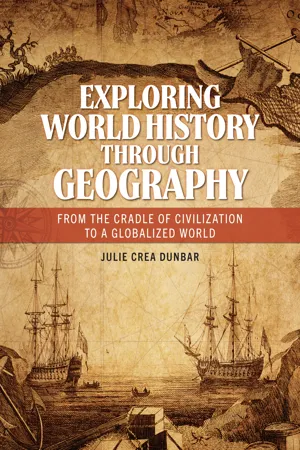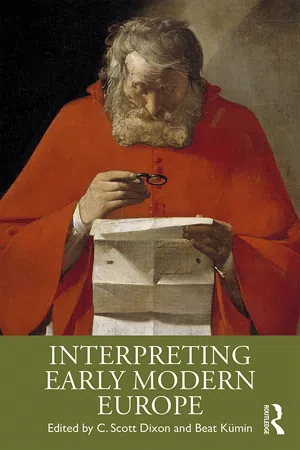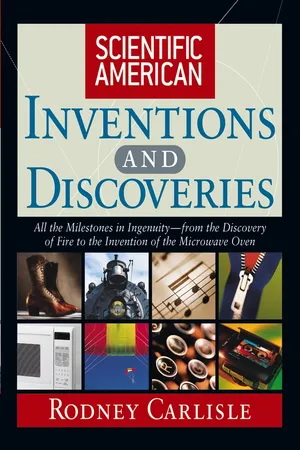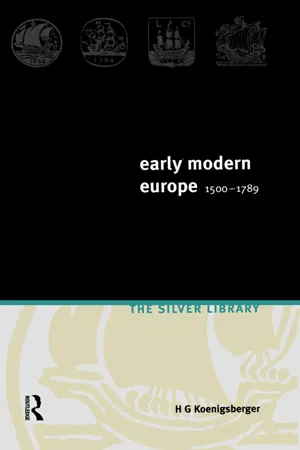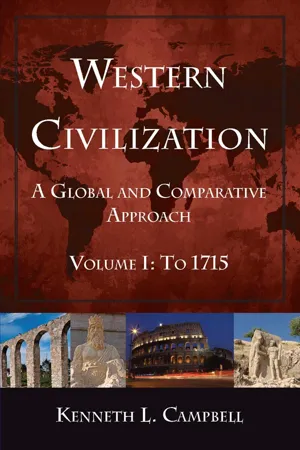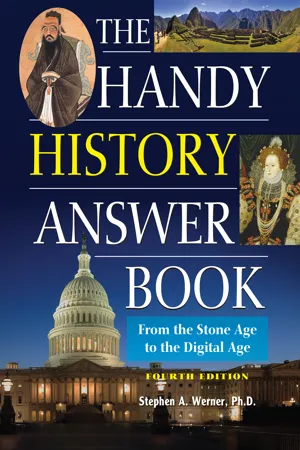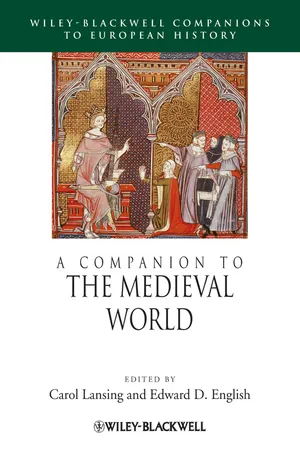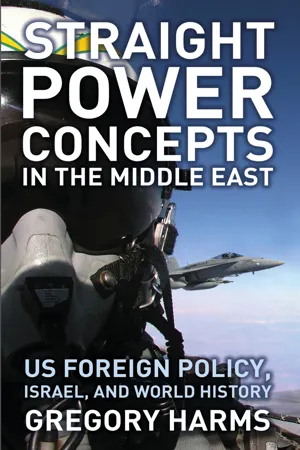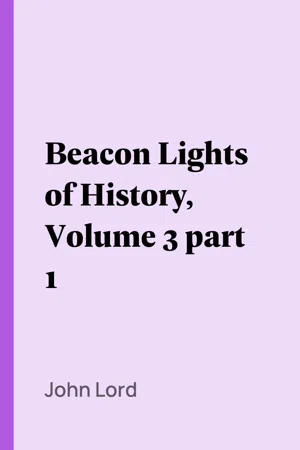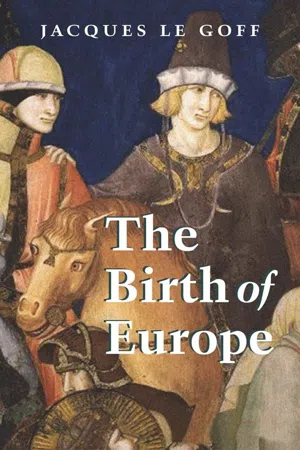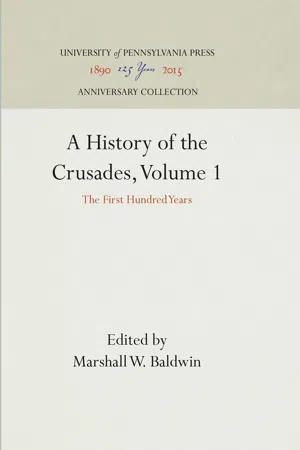History
Medieval Europe
Medieval Europe refers to the period in European history from the fall of the Western Roman Empire in the 5th century to the beginning of the Renaissance in the 15th century. It was characterized by feudalism, the dominance of the Catholic Church, and significant cultural, social, and economic changes. This era saw the development of chivalry, Gothic architecture, and the spread of universities.
Written by Perlego with AI-assistance
Related key terms
1 of 5
12 Key excerpts on "Medieval Europe"
- eBook - ePub
Exploring World History through Geography
From the Cradle of Civilization to a Globalized World
- Julie Crea Dunbar(Author)
- 2022(Publication Date)
- ABC-CLIO(Publisher)
11Europe in the Middle Ages
The Middle Ages refers to the time between the fall of the Western Roman Empire and the birth of the Renaissance. It not only references a time period, but a specific geographic location as well. The term is generally used to describe this period of time in European history. Another word used to describe the time is “Medieval,” which is Latin for “middle age.”The Early Middle Ages (500–1050) saw enormous shifts in the human geography of Europe: Political organization, economy, and societal structure adapted to the instability caused first by the fall of the Roman Empire and then the death of Charlemagne and the Viking invasions by contracting and localizing—in other words, local powers gained more authority as central governments weakened, long-distance trade declined, and the self-sufficient manor and then feudal systems rose.As peace returned and agricultural innovation allowed for increased food production, political organization, economy, and societal structure shifted again, widening to a more regional system. In these High Middle Ages (1050–1300), Europe grew strong in economy and population. It looked outward to trade, exploration, and conquest beyond its borders. But saddled with famine and plague toward the end of this period and into the 14th century, Europe once again focused inward, as its population struggled for survival. Governments, churches, and even physicians could do little to help. Europe’s massive population was cut by one-third in a matter of a few years. Out of this period of decline, however, Europe rebounded.Europeans’ worldview throughout the Middle Ages changed with the circumstances. During the more contracted times of famine and the Black Death, Europeans saw their circumstances as a punishment from God. They blamed the excesses and corruption of the Roman Catholic Church, foreigners, and Jews for the dire circumstances over which they had little control. In good times of economic expansion and exploration, the Europeans viewed the world with curiosity, mixed with a bit of apprehension. They still trusted age-old stories about faraway lands from the Bible and ancient Greek and Roman texts. As they learned more about the world around them, however, they began to think about capitalizing on their knowledge and establishing new trade routes, which would lead into the Age of Exploration. - eBook - ePub
- C. Scott Dixon, Beat Kümin, C. Scott Dixon, Beat Kümin(Authors)
- 2019(Publication Date)
- Routledge(Publisher)
c . 1250 for the ‘Later’ Middle Ages has been debated, but is based on the death of the Emperor Frederick II Hohenstaufen in that year, followed shortly by a long interregnum in the Empire; and by the beginnings of fragmentation in the thought-world of late medieval scholasticism around this time (Hale, Highfield, and Smalley 1965). The idea of calling this whole era, or even just the earlier part of it, the ‘dark ages’ is now something of a historical fossil, though still deserving of serious rebuttal (Nelson 2007). The continuing use of the term ‘medieval’ as a guild label and as a universally recognised (if not always welcome) qualifier for a period of European history tells us that it must be thought to mean something. The task is to attempt to define some of what that meaning includes. It is vital, in what follows, to appreciate that Medieval Europe was in no way static over a thousand years. Generalising about this expanse of time always means describing peoples and cultures on the move. Some would argue that the divisions between early and later medieval history are at least as important as the distinctions between medieval and early modern (Southern 1995–1997).In terms of Europe’s political structures, the medieval period can be book-ended, if so desired, somewhat neatly between the fall of the Western Roman Empire, when Odoacer deposed Romulus ‘Augustulus’ of Rome in 476, to the fall of the Eastern Empire, when the Ottoman Mehmed II conquered Constantinople in 1453 and defeated Constantine XI Palaiologos in battle. In the East, the political, administrative and cultural traditions of East Rome, later to be known as the Byzantine Empire, persisted throughout the period, despite being whittled away by invaders from the East and, notoriously, being despoiled by the Fourth Crusaders in the early thirteenth century. While historians rightly acknowledge the importance of the Eastern Empire, whose culture was for much of the early Middle Ages more productive and sophisticated than that of the West (Bury 1924–1936, vol IV; Herrin 2008), most of the characterisation of the ‘Middle Ages’ has in practice been drawn from events in Western, Latin Europe. In the West, the prevailing political conditions after the fall of Rome were diffuse, at times even chaotic, as different ethnic groups from the East and the North vied for control of fragments of Western Europe. - eBook - ePub
Scientific American Inventions and Discoveries
All the Milestones in Ingenuity--From the Discovery of Fire to the Invention of the Microwave Oven
- Rodney Carlisle(Author)
- 2008(Publication Date)
- Trade Paper Press(Publisher)
PART IITHE MIDDLE AGES THROUGH 1599The period covered in this part of the volume, from about A.D. 300 through A.D. 1599, includes what historians of European history usually call the Middle Ages (or the medieval period) and the Renaissance. The early part of this period is surrounded with numerous popular myths and misconceptions, including the old-fashioned idea that the centuries from about 300 to about 1000 were the “Dark Ages,” during which Europe was dominated by ignorance, superstition, and lawlessness. These assumptions are quite untrue, for churchmen and scholars laboriously copied written texts, perpetuating many of the scientific, legal, and literary achievements of the ancient period. Furthermore, some of the inventions that stimulated the greatest social changes and that led to technical progress occurred in this period. The Middle Ages are the subject of difficult research in rare texts, languages no longer spoken or written, supplemented with the study of artifacts, coins, etymology (the origin of words), art, and archaeology. While better written sources exist for the Renaissance, roughly 1400 to 1599, some unsolved historical mysteries remain for this period as well. For example, we know when eyeglasses first were in use, but we have no certain knowledge of exactly who invented them or where. The same is true of several other inventions, such as the hand crank, playing cards, and the windmill.These centuries have fascinated historians living in modern times for several reasons. During the Middle Ages, the Roman civilization declined, and what had once been the Roman Empire dissolved into many small states, some no larger than towns or counties in the modern United States. North-central Europe, from what is now the northern region of Spain across France and Germany to Poland and Austria on the east, was united under the reign of Charlemagne as Holy Roman emperor from 804 until his death in 814. But over the next centuries, Charlemagne’s empire also declined. Local kings, dukes, bishops, and (here and there) elected leaders ruled and warred to protect their small territories. In some locales, a monastery would provide armed monks who helped maintain order. - eBook - ePub
- H.G. Koenigsberger(Author)
- 2014(Publication Date)
- Routledge(Publisher)
Some economic historians, and especially Marxists, have also seen the late fifteenth and early sixteenth centuries as decisive in the development of capitalism and of the bourgeoisie, a non–feudal, market orientated class. Among the economic historians, too, there are many different views. The Marxists, in particular, have complicated the problem by their use of the term feudalism. They use it not only for the period from the ninth to the thirteenth century and for an organisation of society which depended on fealty and military service (rendered by knights to their princes in return for a fief, a piece of land), and on serfdom and labour services (rendered by peasants to their lords in return for their holdings); the Marxists have extended the term feudalism to cover any society dominated by large landowners and in which the peasants, without being necessarily unfree of performing labour services, are economically and socially dependent on the land owners. On this definition, feudalism is then held to have persisted up to at least the French Revolution, at the end of the eighteenth century, and in Russia and other parts of the world until the revolutions of the twentieth century.This History uses the word feudalism in the traditional way, accepts the conventional periodization of the end of the Middle Ages (but without accepting the humanist view of the period as culturally dark and barbaric) and divides the modern age into an ‘early modern’ period, up to the French Revolution, and a ‘modern’ period, from the end of the eighteenth century to the present.The economic condition of Europe in 1500The economic history of Europe in the Middle Ages had shown distinct rhythms of expansion and contraction. From about the year AD 1000, when the West finally emerged from the age of invasions by Arabs, Vikings and Magyars, Europe experienced a long period of expansion which lasted about three hundred years. Population increased, much new land came under cultivation, towns and cities were founded, and the overall wealth of European society and the standard of living of at least a minority rose steadily. From the early fourteenth century this movement was reversed. Then, in the Black Death, the great plague which raged in Europe from 1348 to 1350, the Continent lost a quarter or more of its population. The area of cultivated land, the size of cities, the volume of trade all shrank drastically, although the standard of living of the mass of the population probably rose.From about the middle of the fifteenth century, and more clearly from around the year 1500, there began a new period of expansion. The epidemics of plague became less frequent and a little less deadly. Population increased again. Deserted fields were ploughed up again and new fields were wrested from forest and marsh. People built new houses on the empty spaces the plagues had left inside the city walls, and soon many towns spilt over their old confines. Expanding trade provided new wealth for merchants, shipowners and bankers. It also provided new wealth for princes and soldiers who used it the way they had always done, to extend their dominions by military conquests or to defend themselves against those who tried to do it at their expense. - eBook - ePub
Western Civilization: A Global and Comparative Approach
Volume I: To 1715
- Kenneth L. Campbell(Author)
- 2014(Publication Date)
- Routledge(Publisher)
By the eleventh century, Europe had started to escape from under the shadow of invasions from Muslims, Vikings, and Magyars. Improvements in agriculture, a period of relative peace, and a warming trend in the climate, leading to a longer growing season, all contributed to an increase in population. A rising population and a surplus of food contributed to a revival of trade and an increase in the number of towns throughout Europe, along with a growing merchant class and new opportunities for education and employment. Monarchs gradually began to assert their authority over their nobles and kingdoms and to revive theoretical justifications for their power. The church had ambitions of its own, and the idea of religious reform was carried to new extremes, orchestrated by an increasingly radical group of churchmen in Rome who gained control of the papacy in the second half of the eleventh century. The eleventh century and those that immediately followed saw the development of a serious rift between church and state, as both vied for the leadership of Christian Europe. This period also saw the emergence of a much more sophisticated medieval civilization marked by important achievements in art, architecture, education, philosophy, law, and economic and political development.1. What do the developments in this chapter reveal about the nature of medieval kingship and political authority?2. What was the basic nature of the relationship between the church and the state from the ninth to the eleventh centuries?3. What factors shaped the changes in religion and politics that occurred during this period?4. To what extent do these centuries deserve to be known as the “Dark Ages”?5. What conclusions might be reached about Mayan and European civilization in this period on the basis of a comparison between the two?Suggestions for Further Reading
Brown, Peter. 2003. The Rise of Western Christendom: Triumph and Diversity, A.D. 200–1000 . 2nd ed. Malden, MA: Blackwell.Coe, Michael. 2005. The Maya . 7 th ed. London: Thames and Hudson.Freedman, Paul. 1999. Images of the Medieval Peasant - eBook - ePub
The Handy History Answer Book
From the Stone Age to the Digital Age
- Stephen A. Werner(Author)
- 2020(Publication Date)
- Visible Ink Press(Publisher)
To better understand this period, one must note that most people, but not all, thought the world was flat. They also thought that the sun, moon, and stars were small objects a few miles up in the air. Most people had no idea that Earth was a planet in a vast, vast universe. So, most people believed Heaven was “up there, beyond the stars” and that Hell was down below Earth. By the Middle Ages, the concepts of Heaven and Hell were well developed.During the Middle Ages, scholars argued that the meaning of life on Earth lay primarily in its relation to an afterlife. Therefore, they believed that art for its own sake had no value, and they even frowned on the recognition of individual talent. For this reason, many of the great artworks of the Middle Ages were created anonymously.What are the characteristics of medieval times?Although the Middle Ages were shadowed by poverty, ignorance, economic chaos, bad government, and the plague, it was also a period of cultural and artistic achievement. For example, the university originated in Medieval Europe (the first university was established in 1158 in Bologna, Italy). The period was marked by the belief, based on the Christian faith, that the universe was an ordered world, ruled by an infinite and allknowing God. This belief persisted even through the turmoil of wars and social upheavals, and it is evident in the soaring Gothic architecture (such as the Cathedral of Chartres, France), the poetry of Dante Alighieri (1265–1321), the philosophy of St. Thomas Aquinas (1225–1274), the Gregorian chant, and the music of such composers as Guillaume de Machaut (c. 1300–1377).What was the structure of feudal society?With the breakup of the Roman Empire, a system called feudalism developed. What follows is a simplified description of the feudal social structure. It was often more complicated than this and often varied from place to place.Kings - eBook - ePub
- Carol Lansing, Edward D. English, Carol Lansing, Edward D. English, Edward D. English(Authors)
- 2012(Publication Date)
- Wiley-Blackwell(Publisher)
Part VII The European Middle AgesPassage contains an image Chapter Twenty-seven Medieval Europe in World History R. I. Moore
The Master Narrative of Academic History
The history of medieval history in the nineteenth and twentieth centuries might be written as that of a series of attempts to secure for it a place in the Master Narrative (as it will be called in this chapter) whose canonization was the founding achievement of academic history in the second half of the nineteenth century. The undisputed basis of that history at least until the 1960s, the Master Narrative told how human achievement had reached its peak in the liberal democracies of the industrial age. Both democracy and capitalist industrialism (which were taken to be inseparable in the authorized version, though not in its Marxist variant) were attributable to the special qualities of European, or Western, or Christian Civilization, and in particular to its synthesis of the rational and democratic traditions of the classical civilization of the ancient Mediterranean with the spiritual power and insights of the Judeo-Christian legacy. This synthesis had been perfected by the Renaissance and Enlightenment, after a millennium of maturation following the decline of the ancient world. Articulated in the Age of (benign) Revolution and diffused in that of Empire, or Improvement, the resultant values imparted to the nations of Europe and the New World both the dynamism that generated world-dominating and world-transforming power and the checks and balances that restrained its exercise, contrasting markedly in both respects with the stagnant and decaying but still absolutist tyrannies of the Middle East and Asia.During the century or so of its pomp, the Master Narrative structured, with relatively minor national and regional variations, the curriculum for the teaching of history almost everywhere in the developed and much of the developing world. And not only of history, but in varying degrees of all the disciplines that conceived themselves as having developed in a historical fashion, or their subject matter as having been to any degree influenced by its historical contexts and circumstances, including those of the modern languages and literatures, even to an extent of philosophy and ethics. The social sciences too, trapped in the Master Narrative precisely because they self-consciously repudiated historical foundations and historical method, in the main accepted without serious question, even if sometimes under protest, that the ultimate achievement of human progress was the breakthrough to capitalist industrialism, which was the reward of the peculiar virtues that characterized European as opposed to other cultures – freedom, effort, thrift, enterprise, the rule of law, and so on. - eBook - ePub
The History of Democracy
A Marxist Interpretation
- Brian S. Roper(Author)
- 2012(Publication Date)
- Pluto Press(Publisher)
3
The early Middle Ages and the transition from feudalism to capitalism INTRODUCTIONThe historical narrative in Chapter 2 concluded with the overthrow of the final western Roman emperor (Romulus Augustulus) in 476 AD . This chapter provides a condensed overview of the early Middle Ages and the emergence of feudalism in Europe, emphasising the scale of the social, economic and demographic decline from 476 to 800 as well as the prevailing social forms of agricultural production that were central to the emergence of feudalism from the ninth century onwards. By the thirteenth century feudalism had, as Anderson puts it, ‘produced a unified and developed civilisation that registered a tremendous advance on the rudimentary, patchwork communities of the Dark Ages’ (1974a: 182). The substantial population growth from the tenth to the thirteenth centuries, including the re-emergence of large towns, and the increasing weight of military, state and religious requirements, placed feudal agricultural production under mounting pressure. A generalised crisis of feudalism ensued, with famine becoming widespread during the early decades of the fourteenth century, followed by the Black Death that swept across Europe recurrently from the first outbreak of the bubonic and pneumonic plague in 1347–9 to the mid-fifteenth century.This prolonged crisis ultimately had different outcomes in Eastern Europe, France and England (Brenner, 1985, 1990, 2007). In Eastern Europe the outcome was intensified exploitation of serfs and peasants by noble landlords, in France it involved the growth of an absolutist tax-gathering and office-providing state, and in England it gave rise to capitalist relations of production in the countryside between noble landlords, capitalist tenant farmers and agricultural wage-labourers. This set of developments is the focus of the second section of the chapter. - eBook - PDF
Straight Power Concepts in the Middle East
US Foreign Policy, Israel and World History
- Gregory Harms(Author)
- 2010(Publication Date)
- Pluto Press(Publisher)
At the bottom of the feudal stratification resided the peasants, or serfs, tending their plots and providing labor service to the lord of the manor in exchange for the plot itself and protection in times of trouble. Though hardly a utopia, serfdom in the feudal network was a notch up from slavery, with peasants enjoying a measure of autonomy and security. What we call feudalism (something its participants did not) lasted basically from the tenth to the thirteenth century. This system, char-acterized by castles, knights, chivalry, and vassalage, plus a tripartite socioeconomic structure composed of the three “estates”—those who pray, those who fight, and those who work—was never and should never be considered as anything well-ordered and consis-tent throughout. Today’s descriptions are generalizations that ease discussion; in practice, the medieval way of life was quite varied, heavier on exceptions than rules, and existing in slightly differ-ent forms from one territory to the next. Nonetheless, the picture 18 STRAIGHT POWER CONCEPTS IN THE MIDDLE EAST we have is a reasonable approximation. But by 1200, this picture begins to change. From its Carolingian roots to the thirteenth century, the feudal Middle Ages remained basically stable for 500 years, although by the thirteenth century, urbanization was beginning to change the face of European history. As population growth, surplus production, and merchant activity increased, towns began to take hold, eventually forming walled cities, or bourgs , typically nestled against a castle, monastery, or cathedral. Operating outside the feudal structure, the towns and their expanding and increasingly wealthy bourgeois class were on the whole independent entities. Charters, guilds, and corpo-rations were developed to define, regulate, and incorporate a town into the feudal scheme of things, and in return towns paid the king. - eBook - ePub
Beacon Lights of History, Volume 3 part 1
The Middle Ages
- John Lord(Author)
- 1998(Publication Date)
- Perlego(Publisher)
Such was the state of society during the existence of feudal institutions,—a period of about five hundred years,—dating from the dismemberment of Charlemagne's empire to the fifteenth century. The era of its greatest power was from the Norman conquest of England to the reign of Edward III. But there was a long and gloomy period before Feudalism ripened into an institution,—from the dissolution of the Roman Empire to the eighth and ninth centuries. I would assign this period as the darkest and the dreariest in the history of Europe since the Roman conquests, for this reason, that civilization perished without any one to chronicle the changes, or to take notice of the extinction.From Charlemagne there had been, with the exception of brief intervals, the birth of new ideas and interests, the growth of a new civilization. Before his day there was a progressive decline. Art, literature, science, alike faded away. There were no grand monuments erected, the voice of the poet was unheard in the universal wretchedness, the monks completed the destruction which the barbarians began. Why were libraries burned or destroyed? Why was classic literature utterly neglected? Why did no great scholars arise even in the Church? The new races looked in vain for benefactors. Even the souvenirs of the old Empire were lost. Nearly all the records of ancient greatness perished. The old cities were levelled to the ground. Nothing was built but monasteries, and these were as gloomy as feudal castles at a later date. The churches were heavy and mournful. Good men hid themselves, trying to escape from the miserable world, and sang monotonous chants of death and the grave. Agriculture was at the lowest state, and hunting, piracy, and robbery were resorted to as a means of precarious existence. There was no commerce. The roads were invested with vagabonds and robbers. It was the era of universal pillage and destruction; nothing held sacred. Universal desolation filled the souls of men with despair. What state of society could be worse than that of England under the early Saxon kings? There were no dominant races and no central power. The countries of Europe relapsed into a sullen barbarism. I see no bright spot anywhere, not even in Italy, which was at this time the most overrun and the most mercilessly plundered of all the provinces of the fallen Empire. The old capital of the world was nearly depopulated. Nothing was spared of ancient art on which the barbarians could lay their hands, and nothing was valued. - eBook - PDF
- Jacques Le Goff(Author)
- 2009(Publication Date)
- Wiley-Blackwell(Publisher)
Palermo became the only town in Christian Europe that could compete with the great Byzantine and Muslim towns. From a cultural and artistic point of view, much translation work was done, with Christians, Jews, and Muslims all in constant collabor-ation, making Palermo not only an exemplary but also an exceptional capital of Christian Europe. At the end of the thirteenth century, the kingdom of southern Italy and Sicily was briefly conquered by the French (Saint Louis’s brother Charles of Anjou (1227–1285) became king in 1268), then in 1282 it was conquered, more lastingly, by the Aragonese, after a massacre of the French known as the ‘‘Sicilian Vespers.’’ Had those con-quests not taken place, this unusual section of Mediterranean Christendom might well have become either independent or else an integral part of the Byzantine or Muslim world. Its example shows that the geography and history of Europe were not necessarily a foregone conclusion. The Twelfth-Century European Renaissance The period from the eleventh to the twelfth century was marked by an essential transformation in Christian Europe. This renaissance of the twelfth century has been generally recognized since the publication in 1927 of a work by the American historian Charles Haskins. Although, as we have seen, the people of the Middle Ages tended generally to camouflage their innovations by speaking of them in terms of a renaissance of ancient culture, the changes that took place in Christendom at this time in truth amounted to very much more than this. Taking a long-term view of European history, I should like to draw attention to the importance, during this period, of the birth or decisive development of a new culture and new attitudes. The first features to mention are the feminization and, as I shall explain, the ‘‘dolor-ization’’ of Christianity. These were accompanied by the extraordinary rise of the cult of the Virgin Mary and a new prevailing emphasis in the cult of feudal europe 75 - eBook - PDF
A History of the Crusades, Volume 1
The First Hundred Years
- Marshall W. Baldwin, Kenneth Meyer Setton, Marshall W. Baldwin, Kenneth Meyer Setton(Authors)
- 2016(Publication Date)
I WESTERN EUROPE ON THE EVE OF THE CRUSADES T h e crusades had their origin in eleventh-century western Eu-rope and to understand them one must know something of the environment in which they emerged. No mere static description of the land and its people can serve this purpose. The picture must be a moving one that shows the basic forces that were slowly molding medieval civilization, for the crusades were a natural product of these forces. The eleventh was the first of the three great creative centuries of the Middle Ages — an era of pioneers, soldiers, and statesmen. During its span the political and economic institutions that had been gradually taking shape since the sixth century were firmly cemented together to form the foundations of medieval civilization. While many of those who were to make the twelfth century an age of saints, scholars, artists, and creative literary men were born before the first crusaders set out for Pa-lestine, their day lay in the future. The great lay figures of the eleventh century, William the Conqueror, the emperors Henry III and Henry IV, Roger I of Sicily, and Alfonso VI of Castile, were soldier-statesmen, and their ecclesiastical counterparts, pope Gre-gory VII, the early abbots of Cluny, and archbishop Lanfranc, were priestly statesmen. They sought essentially power, order, and efficiency. Even the chief monastic order of the period, that of Cluny, represented administrative rather more than spiritual re-form. The hardy peasants who cleared forests and drained marshes to bring new land under cultivation and the Genoese and Pisan seamen who swept the Moslems from the coasts of Europe must have been moved by the same vigorous spirit as their conquering lords. In short, both expansion and organization marked the eleventh century. The crusades were a part of the former and were made possible by the latter. .· 3 4 A HISTORY OF THE CRUSADES I Medieval western Europe had two basic patterns of settlement — the hamlet and the village.
Index pages curate the most relevant extracts from our library of academic textbooks. They’ve been created using an in-house natural language model (NLM), each adding context and meaning to key research topics.
